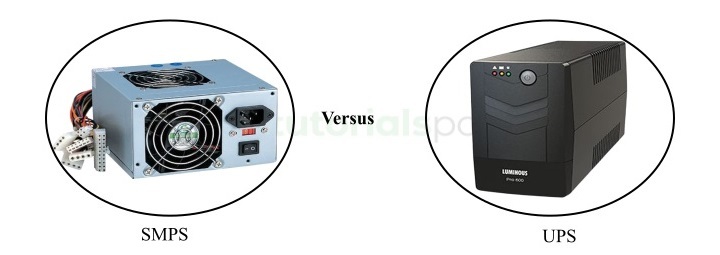
 Data Structure
Data Structure Networking
Networking RDBMS
RDBMS Operating System
Operating System Java
Java MS Excel
MS Excel iOS
iOS HTML
HTML CSS
CSS Android
Android Python
Python C Programming
C Programming C++
C++ C#
C# MongoDB
MongoDB MySQL
MySQL Javascript
Javascript PHP
PHP
- Selected Reading
- UPSC IAS Exams Notes
- Developer's Best Practices
- Questions and Answers
- Effective Resume Writing
- HR Interview Questions
- Computer Glossary
- Who is Who
Difference between SMPS and UPS
Both SMPS and UPS are types of power supplies used in various electronic devices like computers. Although, SMPS and UPS are completely different from each other in terms their primary function and many other parameters. The fundamental difference between SMPS and UPS is that SMPS (Switched Mode Power Supply) is designed to convert and regulate electricity for a specific application, while UPS (Uninterruptible Power Supply) is designed to provide backup power supply during mains power outages.

In this article, we will discuss the important differences between SMPS and UPS. But before discussing the differences, let us first get a brief overview of SMPS and UPS individually.
What is SMPS?
SMPS stands for Switched Mode Power Supply. It is an electronic circuit which is used for converting and regulating electric power for a specific application like to power the motherboard, CPU and other components of a computer system. SMPS is also used in several other electronic devices like laptops, mobiles, smartphones, tablet, etc. where regulated power supply is required.
SMPS consists of an electronic rectifier circuit to convert alternating current (AC) supply into direct current (DC) supply. This rectified output supply is then filtered using electronic components like capacitors to eliminate ripples. At the final stage, a voltage regulator is used to regulate the output DC voltage withing the desired range.
SMPS is very commonly used in small sized electronic devices like desktops, laptops, and more due to its advantages including compact size, less heat generation, high efficiency, etc.
What is UPS?
UPS stands for Uninterruptible Power Supply. It is also a very popular electronic device used in the area of electronics. The primary function of a UPS is to provide backup electric power in the case of main power outages.
UPS provides electric power to the connected devices for a short duration of time when the main electric supply fails. UPS is basically an electronic circuit which act as an interface between load devices and power storage units. Thus, the UPS charges batteries when the power is available, and provides this stored power to the connected devices when main power fails.
UPS is mainly used to provide backup power to such electronic devices which are very sensitive to sudden power failure like computers. They provide protection against hardware failure, data loss, etc. by providing temporary backup power for a short during time, allowing for a safe shutdown of the system.
Uninterruptible power supplies are widely used as backup power supply in homes, offices, hospitals, data centers, etc. They protect electronic devices from damages and increase their lifespan.
After getting an overview of SMPS and UPS, let us now discuss their important differences.
Difference between UPS and SMPS
The following table highlights all the significant differences between SMPS and UPS:
Parameter |
SMPS |
UPS |
|---|---|---|
Full Form |
SMPS stands for Switched Mode Power Supply. |
UPS stands for Uninterruptible Power Supply. |
Main function |
The primary function of SMPS is to convert and regulate electric power as per the need. |
The primary function UPS is to provide backup power supply during main power outages. |
Input power source |
SMPS takes input electric power from the supply mains. |
UPS contains built-in rechargeable batteries to provide backup power. |
Output power |
SMPS provide DC power output for powering electronic circuits. |
UPS provides AC power output to connected load devices. |
Type of transformer used |
In SMPS, high-frequency transformer is used. |
In UPS, low-frequency transformer is used. |
Backup capability |
SMPS does not offer any kind of backup capability. |
UPS provides backup capabilities to connected devices. |
Size |
SMPS is relatively smaller in size. |
UPS is larger is size than SMPS. |
Power storage capability |
SMPS does not any kind of power storage capability. |
UPS has battery units to store power. |
Cost |
SMPS is usually less expensive. |
UPS is more expensive than SMPS. |
Energy loss |
SMPS involves low energy loss. |
UPS has higher energy losses due to battery charging and conversion process. |
Voltage regulation |
SMPS provides regulated output voltage but it is affected by fluctuations in input voltage. |
UPS provides a regulated and stable output voltage which is independent of the input voltage variations. |
Built-in run time |
SMPS does not have a specific built-in runtime, as it directly operates on the supply mains. |
The run time of UPS is limited which depends upon the battery capacity. |
Circuit complexity |
The electronic circuit of SMPS is simpler. |
UPS has a complex electronic circuit to charge batteries, switching between power sources, power inversion, etc. |
Application |
SMPS is mainly used for AC to DC conversion and voltage regulation in various electronic devices like computers, laptops, etc. |
UPS is widely used as a backup power supply to provide power during main power outages. |
Conclusion
Both SMPS and UPS are types of power supply used in the field of electronics. SMPS (Switched Mode Power Supply) is used for power conversion and regulation purposes, while USP (Uninterruptible Power Supply) is used for providing power supply when mains power supply fails. In the case of a computer system, SMPS is found inside the CPU cabinet, and the UPS is found as a separate unit.

